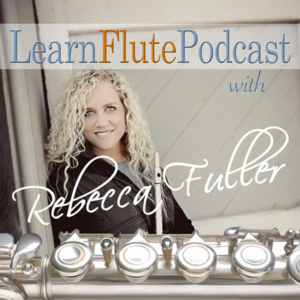Learn Flute Podcast SHOW NOTES:
In this episode, we will answer the question ‘What should you look at first in sheet music?’ so you can become an excellent music reader.
This is the Learn Flute Podcast Episode 022.
Yeah!
You’ll learn:
What this podcast will be all about
- Information on this podcast is supplemental to LearnFluteOnline.com
- The first things to look at when you start a new piece of music
- How knowing the title and composer can help you play
- How to become a part of Learn Flute Online
- What you can look forward to learning from listening
Learn Flute Podcast 022
Press the Play Button to Listen Now:
Welcome to Episode twenty two of the learn Flute Podcast. I’m Rebecca Fuller, your host and the expert at Learn Flute Online dot com where you can learn and enjoy everything flute.
Today, we’re going to be talking about what you should actually be seeing when you view your music. Now, this is actually a really great lesson, and it’s something I show my private students often because it makes such a big difference. So, let’s get going!
The reason I thought to talk about this subject today is because I recently had a lesson day with a whole set of students who were all about the same age and about the same level. The interesting thing I noticed as the day progressed along was that they all seemed to make about the same mistakes on the same pieces, in the exact same spots. Now, this caused me to reflect a bit and assume that these types of mistakes were best fixed by being prevented.
There are times when I just have to say that the human brain just tends to work in certain ways and we’ll have to learn skills as we need them. Just like J. P. Morgan said with the quote of “Go as far as you can see; when you get there, you’ll be able to see farther’.
But, we all know from experience that even an ounce of prevention is worth several pounds of a cure.
So, let’s talk about this with a little visual of just starting brand new on a piece of music. Imagine yourself taking it out of the file or opening to the new page in a book. Smell it if you need to, but then let’s freeze right there are see what actually happens.
There’s a small stage that every student goes through about right now, and that’s…. ‘just let me at it’. Haha, you know what I’m talking about. You almost unconsciously want to start the fingerings right away. Because we like to view sheet music as something to physically ‘do’.
But, I’m going to say, ‘whoa nelly, back up the track, and hold the phone’ because there are a few things that must be done before you go and attack this new tune. Ha, of course I’m exaggerating just a tad bit here, but for some of you this will ring pretty true.
The very first thing, and I mean theee very first item of business when picking up a new piece of sheet music is to do what I call ‘the scan’.
Think of taking a quick skim or a flash look up and down the page. It just takes a second. This will get you familiar with a few things like, how long is this piece, and for many this is where you either get your intimidation factor on or your confidence hat. haha
This is the best time to do a quick ‘chunking’ in your mind where you see the larger parts of the music in big chunks or perhaps it all looks just like one big mass. It just depends on the piece. And your level of course.
The next thing we’ll need to do is move back up to the top and scan from left to right above the staff line. You’ll possibly see a tempo marking or terminology like ‘lento’ or ‘presto’. This lets you know if you’re going to be polishing a quick tempoed tune or a slow flowy one. Many times there is no marking at all there, but if there is- you should definitely spy it from the get-go.
Now, after we’ve checked to see if there’s a tempo marking we move our eyes over to the middle of the page where the title is. Get some clues here. Most times the title will give you an idea of what the music is going to ‘feel’ like.
Many budding musicians learn and play so much better once they have an idea of what flavor the piece is going to be. For example, there are a lot of generic titles like ‘minuet, bourree, andante, or just plain study, etcetera’, but if you see the piece is titled ‘blue water over gently rippling sand’ you’ll definitely have an idea of the direction you may be going in.
So now let’s move onto the right side of the page where you should see the composer. If it doesn’t have one it’s probably because it’s a study or something your teacher designed for you, and there’s nothing much to put there, but most written music has credit given to the person who actually composed it and put it on paper.
The reason this is important is because we can get more important clues from knowing a bit about this person. For example, if you happen to be playing a piece by Johann Sebastian Bach, (and I guess I should mention if you have studied with me) then you’ll know that there are certain tricks you’ll need to use as you play such as the trills and other skills.
Of course I don’t have time to go into details about that here on this podcast, but you can always join us over at learn flute online dot com in the membership area where there are literally hundreds,.. and almost a thousand at the time of this recording of video lessons all in progressive order for you to learn from me with. I do go through certain composers and show you what is important to know and how that affects your playing. This is all about style, folks. And flute players love style!
Ok – I guess I should mention that everything I’ve talked about so far happens within about 3 seconds of picking up your music. Ha, it’s quick but oh so important!
Let’s move on now to the part you’ve been waiting for; and that’s looking at the lines the notes are actually printed on.
We can brush past the treble clef only because we just need to notice that it’s there and that’s all. If by chance there’s a bass clef or alto clef written there, then we’re in trouble because that means we purchased the wrong music. Remember, flutes play in the treble clef.
And now, for the pinnacle of this whole episode- since we read from left to right (in music anyway) we now see the little space after the clef sign that is the place for our key signature. I feel like shouting “tadaaaaa!” here because this is the reason there are so many mistakes when sight reading new pieces of music here. Yup.
We just need to look and ponder for a second or two on the idea that there may be certain flats or sharps in our piece. Now… before moving past this little spot we’ll need to take another quick scan through the piece and especially the very first line. What notes will be affected by this key signature? We need to think about that and put a mental highlight, or even a real highlight on a few of them so that your head is shifted into the right gear.
I’m telling you – this is where it’s at. Such a large percentage of mistakes come from not comprehending what key we’re in and then taking a quick moment to see how that affects what is coming. Yup, Yup. Really big deal. So, I hope if you’ve learned anything from this podcast this is it. Check the key signature and take a few moments to browse the piece. It’ll save you a lot of time and a lot of trouble, that’s for sure!
Lastly here in this episode we need to realize that immediately after the key signature comes the time signature. This doesn’t seem to have quite as big of an impact as the key does, but it sure makes a difference.
If you just start a piece assuming your quarter notes get one count you may be in for quite a surprise that the melody won’t sound quite right – especially if it’s actually written in six eight time. Now, if you haven’t moved through the lessons far enough to know what I’m talking about exactly here, no worries. Just keep moving through those modules I’ve set for you and you’ll get there. And, you’ll be a much wiser person for having listened to this as well.
Well, thanks so much for listening today. I appreciate your effort and enthusiasm for this beautiful instrument flute. I hope you have time to come in and get a lesson this week over at learn flute online dot com where I’ll be taking you through the ins and outs of how to play the flute. You’ll actually get really good, and enjoy your time learning.
This has been episode twenty two. I’m Rebecca Fuller your instructor and friend.
Bye Now!
Thank you for Tuning In!
Please consider subscribing and taking a minute to leave a review and rating for the podcast on iTunes.
I hope you’ve enjoyed learning all about the flute today as we explore the question – “what should you look at first in sheet music?” Join us for the next episode.







